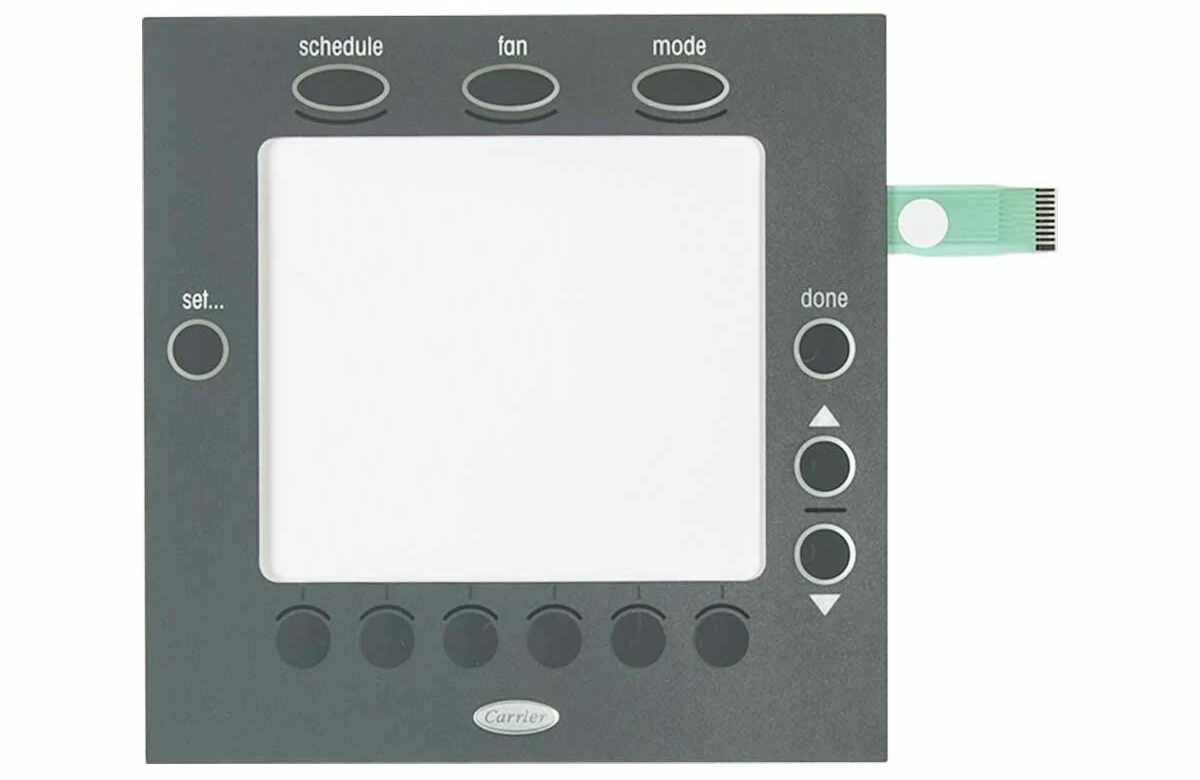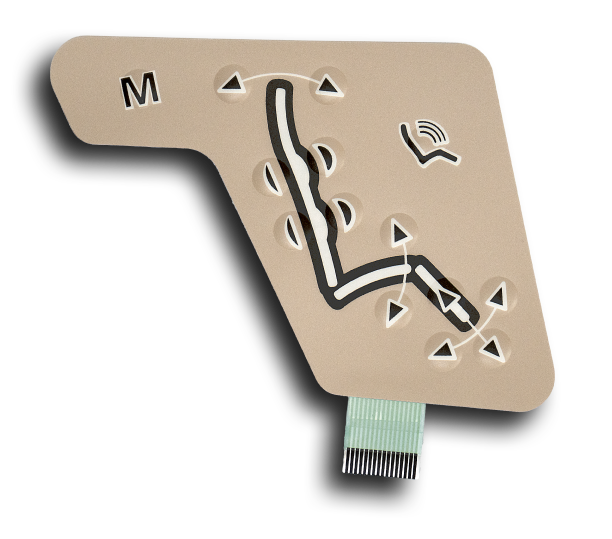Exploring the Production Process of Membrane Switch for Numerous Industries
The production procedure of Membrane switches is an intricate endeavor that demands precision and attention to detail. From choosing proper materials to executing strenuous quality control steps, each step plays a vital duty in ensuring functionality. Various sectors, including medical and vehicle, depend on these parts for their distinct applications. Recognizing the ins and outs of this process discloses substantial understandings into just how these buttons are created and their effect throughout diverse fields.
Recognizing Membrane Switches Over: A Summary

Secret Materials Used in Membrane Switch Production
In Membrane button manufacturing, the selection of crucial materials greatly affects functionality and durability. Conductive products, adhesives, and finishings play important duties, while substrate selection impacts general performance and dependability. Comprehending these components is necessary for enhancing the design and manufacturing of Membrane switches.
Conductive Materials Introduction
Conductive products play an important duty in the performance of Membrane switches, making sure reputable electrical connections within the tool. Commonly utilized materials include silver, copper, and carbon-based inks, each offering distinct advantages. Silver is preferred for its high conductivity and sturdiness, making it excellent for applications requiring robust performance. Copper, while slightly much less conductive than silver, is a cost-effective option usually utilized in printed circuits. Carbon-based inks provide a versatile alternative, suitable for applications where flexibility and reduced prices are focused on, although they have actually reduced conductivity compared to metal options. The option of conductive materials straight affects the general reliability, life expectancy, and performance of the Membrane button, making it an essential factor to consider in the manufacturing process.
Adhesives and Coatings
Coatings and adhesives are important components in the production of Membrane buttons, giving vital bonding and safety buildings. These products assure that numerous layers of the switch, consisting of graphic overlays and wiring, stick securely to each other, boosting longevity and capability. Frequently utilized adhesives include pressure-sensitive adhesives (PSAs) and epoxy-based solutions, which supply strong adhesion and durability. Coatings, such as polyurethane or acrylic, serve to safeguard versus ecological factors, consisting of wetness, abrasion, and chemicals. Furthermore, layers can boost tactile feedback and aesthetic allure, contributing to the general user experience. The option of appropriate adhesives and coatings is essential for enhancing performance and durability in diverse applications across different sectors, guaranteeing that Membrane switches over meet details functional needs.
Substratum Selection Elements
Substratum choice plays a crucial function in the production of Membrane buttons, as it greatly influences their total efficiency and toughness. Trick materials such as polyester, polycarbonate, and adaptable published circuit boards (FPCBs) are commonly utilized for their unique residential or commercial properties. Polyester is favored for its cost-effectiveness and resistance to abrasion, making it ideal for applications with high wear. Polycarbonate deals remarkable quality and effect resistance, perfect for environments requiring high exposure. FPCBs give enhanced flexibility and are usually made use of in complicated styles. The selection of substratum additionally affects elements like thermal stability, chemical resistance, and ease of printing. Eventually, picking the appropriate substrate is essential for making sure the functionality and durability of Membrane switches over across different industries.
The Layout Refine of Membrane Switches Over
The design process of Membrane buttons is an important stage that greatly influences the performance and looks of the final product - membrane switch manufacturer. It begins with defining the specific demands of the application, including dimensions, button layout, and tactile comments preferences. Designers should consider individual interaction, making sure that the switch is user-friendly and accessible.Next, products are picked based upon sturdiness, versatility, and ecological resistance. The combination of graphics and branding aspects is likewise vital, as it improves aesthetic allure and communication. Prototyping permits repetitive screening, enabling adjustments based on customer comments and efficiency evaluations.Additionally, the style needs to represent the electrical components, such as ports and circuits, making sure dependability and simplicity of use. Eventually, an effective style harmonizes functionality, looks, and customer experience, leading the way for effective manufacturing and lasting performance in more tips here numerous industries
Printing Strategies for Membrane Switches Over
The printing methods used in Membrane button manufacturing play an important duty in identifying the end product's high quality and functionality. Screen printing supplies advantages such as durability and lively shade application, while digital printing technologies supply adaptability and precision in design. Comprehending these approaches can considerably influence the general effectiveness of Membrane switches in numerous applications.
Display Printing Advantages
Countless benefits make display publishing a preferred technique for producing Membrane switches. This approach permits for top notch, in-depth styles and lively colors, which are essential for individual interface applications. Display printing is particularly effective for applying thick ink layers, enhancing longevity and responsive feedback. On top of that, it uses superb adhesion to various substratums, guaranteeing long life in demanding environments. The procedure is cost-effective for huge production runs, as it lessens configuration time and waste. Display printing sustains a vast array of inks, consisting of specialized and UV-curable choices, enabling flexibility in style. Its capability to create constant results throughout multiple systems makes it a dependable option for makers going for top quality and efficiency in Membrane button production.
Digital Printing Innovations

Advancements in digital printing technology are changing the production of Membrane buttons, providing makers innovative solutions that boost design adaptability and effectiveness. Digital printing permits elaborate layouts and high-resolution graphics, allowing custom branding and capability without the restrictions of traditional methods. This strategy decreases arrangement times and expenses, facilitating much shorter manufacturing runs and marginal waste, making it optimal for businesses with differing needs. Furthermore, advancements in ink formulations supply far better sturdiness and attachment, making certain durability in different atmospheres. As sectors increasingly look for complex and customized styles, electronic printing attracts attention as a vital technique, setting a new requirement in Membrane button manufacturing. The combination of these innovations settings producers to fulfill evolving market requires effectively.
Setting up and Layering of Membrane Switch Elements
Cautious setting up and layering of Membrane button components are crucial to ensuring capability and sturdiness. This process begins with the accurate positioning of numerous layers, consisting of the visuals overlay, sticky, circuit layer, and support product. Each component has to be carefully positioned to preserve electric stability and user interface responsiveness.During setting up, conductive traces are related to the circuit layer, commonly made from products like polyester or polycarbonate. This layer is essential, as it beams when pressure is applied. The adhesive used for bonding these layers is also chosen for its capability to sustain ecological tensions while preserving a protected bond.Heat and pressure are often applied throughout the setting up process to identify that the layers adhere appropriately without endangering the capability of the button. Attention is provided to the edge securing to shield versus dampness and impurities, securing the longevity of the Membrane button in various industrial applications.
Quality Assurance Measures in Membrane Switch Manufacturing
Quality assurance measures play a vital duty in ensuring the reliability and performance of Membrane changes following the setting up and layering of their elements. In the manufacturing procedure, numerous vital examinations are conducted to promote top quality standards. These include visual examinations for defects in printing and adhesive application, in addition to functional examinations to validate the responsiveness of each switch.Additionally, ecological screening is carried out to examine the buttons' sturdiness against temperature fluctuations and humidity exposure. Makers often carry out statistical procedure control (copyright) methods to keep an eye on manufacturing consistency, allowing early detection of anomalies.Furthermore, traceability systems are established to track elements and materials, making certain liability and facilitating recalls if essential. Calibration of equipment and adherence to industry standards are also important to maintaining product integrity. Collectively, these top quality control actions protect the performance of Membrane switches over throughout various applications, eventually improving client satisfaction.
Applications of Membrane Changes Across Different Industries
Membrane switches are made use of throughout a varied array of sectors, showcasing their convenience and adaptability. In the clinical market, they supply trustworthy and water-proof user interfaces for gadgets such as analysis devices and infusion pumps, making certain health and simplicity of use. The automotive sector employs Membrane buttons for control panel controls, enabling smooth content communication between the vehicle driver and automobile systems.In consumer electronic devices, these buttons are discovered in devices and handheld gadgets, providing a streamlined, contemporary aesthetic while enhancing additional resources functionality. Industrial applications additionally leverage Membrane switches for machinery control panels, where durability and resistance to extreme conditions are essential.Furthermore, the aerospace and protection fields make use of Membrane buttons for cockpit instrumentation and communication systems, focusing on dependability and efficiency under extreme conditions. In general, Membrane buttons play a vital duty in enhancing the user experience and operational performance across various domain names.
Frequently Asked Questions
The length of time Does It Take to Produce a Membrane Switch?
The production time for a membrane switch generally ranges from a few days to numerous weeks - membrane switch manufacturer. Elements influencing this period consist of style complexity, material accessibility, and production volume, all influencing the overall timeline noticeably
What Is the Normal Life Expectancy of a Membrane Switch?
The common life-span of a membrane layer button normally varies from 1 to 5 million actuations, depending on elements such as worldly top quality, environmental conditions, and usage regularity, considerably influencing longevity and total performance.
Can Membrane Switches Over Be Custom-made for Particular Applications?
Membrane switches can indeed be personalized for specific applications. Their layout flexibility permits changes in size, form, colors, and graphics, making sure compatibility with special demands across different sectors and improving functionality and customer experience.

Are Membrane Switches Over Eco-friendly?
The environmental effect of Membrane switches over varies. Some materials utilized may not be green, while improvements in manufacturing processes are increasingly concentrating on sustainability, intending to reduce waste and promote recyclable elements in their manufacturing.
What Are the Common Failing Settings of Membrane Buttons?
Typical failure settings of Membrane switches consist of delamination, glue failing, damage from use, wetness access, and electric failings. These concerns can considerably affect capability, efficiency, and life-span in numerous applications across various markets. Membrane buttons can be customized to fit specific layout requirements, such as size, shape, and functionality, making them very adaptable.The construction generally involves several layers, consisting of a visuals overlay, sticky, and a circuit layer, which function together to develop a seamless customer experience. In Membrane button manufacturing, the option of crucial products substantially influences capability and longevity. The auto sector utilizes Membrane switches for dashboard controls, making it possible for smooth communication between the vehicle driver and vehicle systems.In consumer electronic devices, these switches are discovered in appliances and handheld gadgets, using a smooth, modern-day visual while enhancing capability. Industrial applications also take advantage of Membrane switches over for equipment control panels, where longevity and resistance to rough problems are essential.Furthermore, the aerospace and protection fields make use of Membrane buttons for cockpit instrumentation and interaction systems, focusing on dependability and performance under severe conditions. Membrane buttons can indeed be personalized for certain applications.